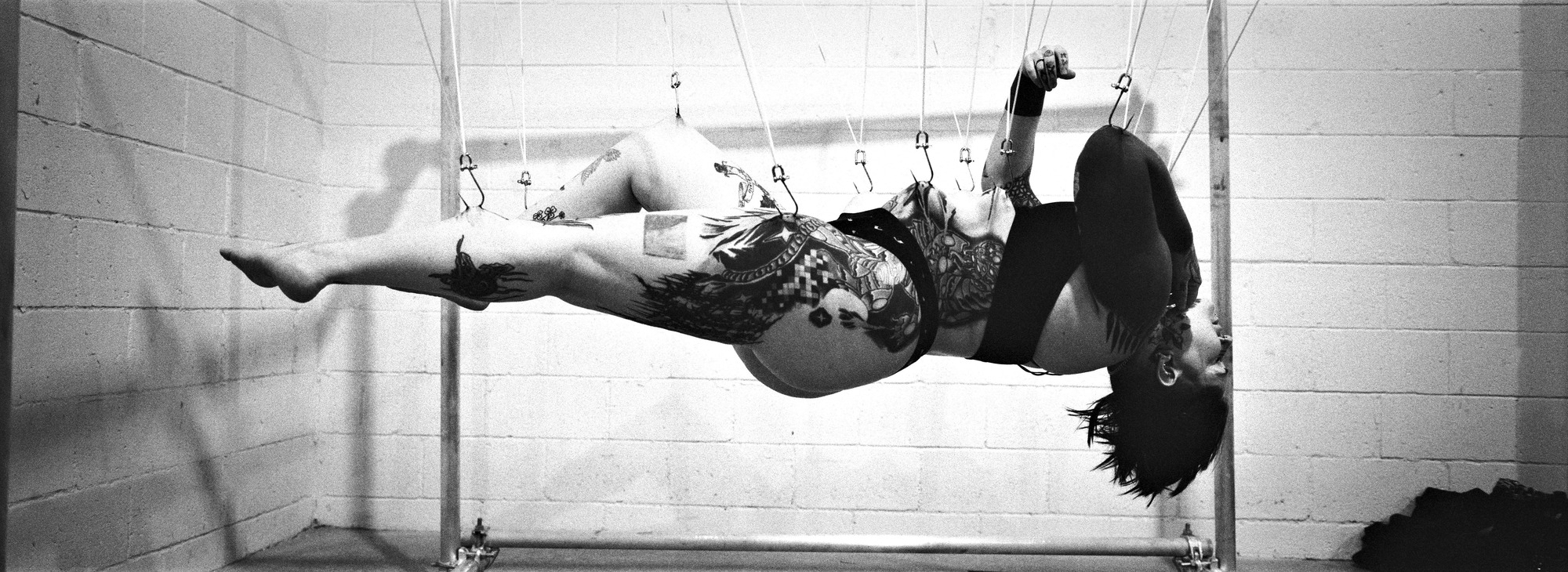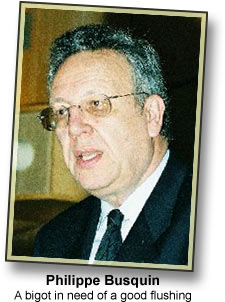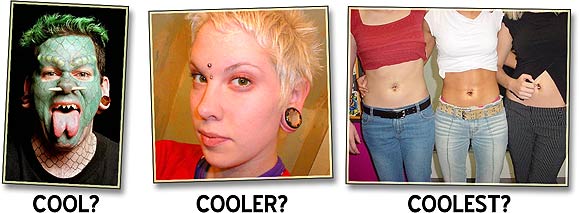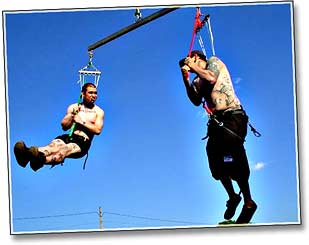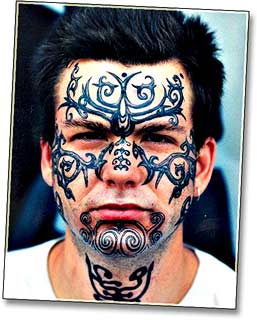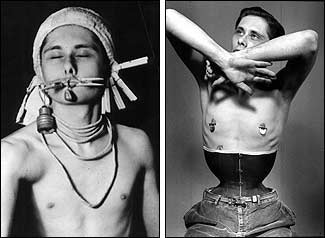
is Stupid and Dangerous aka Your only idol should be YOU |
There ain’t no rules around here! We’re trying to accomplish something.
– Thomas Edison
Something I’ve often heard said about India is that if people have done it, they’ve probably done it in India at some point in history. Every form of body modification, every ritual, every religion, and every philosophical theory has been explored in the incredibly broad intellectual and spiritual landscape that is India, and all my experiences with India have lead me to believe that on the whole it’s a land that encourages one to be oneself rather than feeling a need to conform to some role set forth by others1.
One of my favorite verses from the Bhagavad Gita reads,
It is better to do your own duty
badly than to perfectly do
another’s; when you do your duty
you are naturally free from sin.
– chapter 18, verse 47
In introduction I’d also like to point out what brilliant graphic designers the Nazi party were, and how good they were at ritualizing their politics and social goals — the film Architecture of Doom even goes so far as to suggest that Nazism was first and formost an aesthetic movement (“the cult of the beautiful”). But just because they were good at these tasks doesn’t mean that their underlying philosophies were valid on other subjects.
Likewise, there were many brilliant scientists working for the Nazi regime; much of our modern medicine and a vast majority of our space technology is derivative of their work. However, that doesn’t mean that Nazism is valid either — it means that the science was valid. I think we’re prone to make this mistake quite commonly — because someone is good at one thing, we assume that their views on other subjects must be good as well.
I’d like to now move to discussing one of the most persistent and misleading myths of modern body modification culture; that of the Modern Primitive — a cult of idolization and emulation of various amalgams of indigenous cultures around the world. Self-identified modern primitives tend to embrace the aesthetic and often modernized ritual based on those of these tribal peoples, while holding them up as something to be admired, ignoring the fact that the vast majority were on many levels absolutely brutal and repressive cultures that would have been truly miserable to live under given our modern desires for self-determination and freedom.
That is, they make the mistake of saying “this modification is beautiful” and “this ritual is profound”, and then assuming associated philosophies and lifestyles are also beautiful and profound. As true as the first two statements may be, this line of thinking is no more valid than becoming a neo-Nazi because you appreciate the talented work of Albert Speer or Werner Von Braun — or enjoy Wagner.
The “noble savage” is of course, with few exceptions, a myth. You’re more likely to find this romantic vision in Northern Scotland than you are in the jungles of southeast Asia or the African plains; the “savage” life tended to be just that: savage. Life was rarely idyllic. One’s place in life, from slave to ruler, was dictated from birth and body modification and ritual were tools used to hold that fragile system together, and fearful spiritual codes did their best to explain and justify this world. Is the “noble savage” of modern primitivism something to aspire to, with its beautiful self-expression, empowering rituals, and peaceful Gaia-loving spirituality? Sure, but so is being a Jedi Knight and neither exists in real life.
In modern times many of us use body modification as a tool to become one with God; that is, to exercise control over our physical and metaphysical destinies… Modifying your body as an act of individualism echoes eating the fruit of the tree of knowledge — it’s an act of taking control. It’s an act of liberation.
Unfortunately, as I just mentioned, as beautiful as they were the modifications of most indigenous cultures were very much the opposite — they used body modification as cultural prisons, to ensure conformity and to protect social structure. Their stretched piercings were done at specific times of their life to mark their transition from one social role to another, and their scars were markers of group identification rather than individual. The modifications served a specific and pre-determined purpose — they were (as we accuse corporate-government actions these days), “system sustaining”. That is, their culture of body modification existed not to empower the individual, but to empower and sustain the group.
Certainly there was a great deal of validity in this — for them. As our societies become larger though, more resilient, and more autonomous, it’s essential that we shift our efforts from simply sustaining the society to sustaining and evolving the individual. We’ve finally reached a point in our cultural evolution where we’ve built a solid enough foundation to do so2.
On the other hand, we’ve also reached a point where we’ve given truly enormous levels of power to corporations who profit by mass-producing a cultural product (pop music being an obvious example thereof) which, while profitable, offers little toward the individual or spiritual growth of the people consuming it. Body modification has experienced explosive mainstream popularity over the past fifteen years and we face the risk that it will become commodified as well, which would deeply damage its ability to enlighten by wrapping it in the thick fog of fashion.
In indigenous cultures body modification was not apt to enlighten in and of itself — it was simply the uniform that one was expected to wear. It meant one belonged to a group. What we should be fighting to encourage is a cultural environment where a navel piercing or stretched ears or tattoo isn’t about being part of a group — it’s about being and defining yourself (regardless of who does or does not have that modification as well).
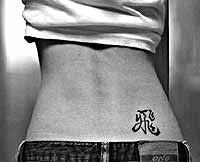 An email I received recently: >At your websit i saw this >beautifull Kanji tattoo!! I >hope one of you know the >menaing, because i really >like it, and want to know it! |
How can we do that?
I’d like to offer a few general tips to illustrate how we can move in this direction, beginning with never get flash and along the same lines, never get a tattoo you don’t understand. Certainly there’s space for a little empty decoration, but I hope you’ll consider the value in having genuine meaning on your body. After all, you are permanently etching this logo into yourself — Maori chiefs, who were one of the rare people in history who’s tattoos had deeply individualist meanings, would often use a drawing of their tattoo instead of their name when signing legal documents.
What is your name? Something handed to you by your parents? Some meaningless phonemes applied to you without your consent? Some shallow name shared by hundreds of thousands of people on the planet? A useful “tag” certainly, but not who you are… Your tattoos on the other hand have the potential to truly represent you — to mark you with identity in a way that you see fit, as you see yourself and as you’d like the world to see you.
 By supporting small businesses, you make it harder for faceless corporations to seize the market and pervert the community to their needs. |
I would hope it would be obvious what message is being sent when you decide that some anonymous done-a-thousand-times piece of flash off the wall, or a pretty symbol of dubious meaning from some language you’ve never spoken a word of can represent you better than something you actually worked on yourself. You can’t draw you say? Big deal! That’s why tattoo artists exist. They’re not just guys that are good at tracing — the majority are valid artists in every sense of the word… Artists that specialize in working with you to take your feelings and beliefs and making them a permanent part of you. Just make sure they’re yours3.
I’d also like to propose that you support local companies and support craftsmen over factories. I’ve spoken about this at greater length in previous columns, but we need to understand how to use the system to our benefit. Large companies are quickly dominating the jewelry market (ten years ago almost all jewelry was being made by small local craftsmen and a handful of small companies, whereas now we’re seeing international corporations using sweatshop labor to mass-produce low-quality “individualism”) — if we (the market) don’t aggressively resist this, small vendors will be all but extinct within the decade. As soon as that happens, you’ll see this community starting to be defined by corporations, not individuals.
 “Killed a dude.”
|
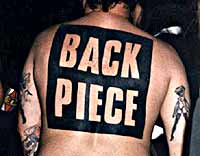
Keep your sense of humor strong!
|
I think it’s also a good idea to take yourself seriously, but not too seriously. What I mean by that is never forget the idiom “all work and no play makes Jack a dull boy.” Should you take your modifications seriously and use them to further personal growth? Absolutely! But you should also be willing to play with your body, and sometimes just be stupid for stupid’s sake. As you progress as an individual you’ll certainly face terrifying challenges, and without a sense of humor it will be hard to appreciate your failures as much as your victories.
When you’re defining yourself, avoid posturing. That is, don’t “act tough” and don’t try and get modifications specifically to affect your relationships and interactions with others. If you do that, you’re inversely falling into a conformist trap. While it’s true that your borders are in part defined by your relations with others, it’s important that the process of defining those borders is truly under your control, rather than simply in reaction to them. Or to put it another way, don’t avoid getting a [meaningful] navel piercing because you think it’s too common, and don’t get a [meaningless] uvula piercing4 just because you think it’s rare.
Along those lines, my final tip is trust yourself and who gives a damn what anyone else thinks! This is about you, isn’t it? Let’s assume for a moment that you’ve actually put some thought into what you’re doing (and if you’re not willing to do that, just stop reading now and switch to FOX News or something) and believe that you need to do a given mod in order to keep moving forward on a personal or spiritual level. If this is the case, anyone — be they parents, friends, partners, employers, whatever — that tries to stand in your way might as well be trying to kill you. In a world that understands that expression is a basic right — a core truth that makes an individual free — the act of restricting this right is one of the most grievous sins one can commit.
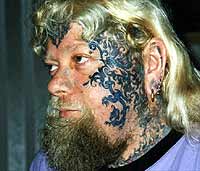 If it feels good, do it. |
The saddest part is that most of us allow it to happen because we’re afraid… Afraid to hurt our parents’ feelings, afraid to lose our jobs, and afraid to get bad service at a restaurant. Well, guess what — the only reason that injustice exists is because so many of us allow it and prop it up. Ultimately slavery ends when people emancipate themselves; it doesn’t just happen on its own and no one can do it for you.
Actually, there is one last “rule” — probably the most important one: everything you just read here is a half-truth. Breaking the rules is essential to exploring the full landscape of life — you just have to understand the rules first to appreciate the value in breaking them5.
Really, the key I think is just to be yourself and define who you are solely by who you are. It’s not relevant who your friends are. It’s not relevant who lives in your community. It’s not relevant who you’re descended from. It’s not relevant that people with your color of skin were once slave owners of people with another color of skin or vice versa. All that’s relevant is who you are. Anything else is just a distraction.
And when you figure out who you are, and protect and ennoble that person, and fight for them and allow them to express themselves, you will be free and you will be well on your way to becoming a God.
Getting back to my original slander, I certainly encourage people to draw inspiration from all sources. But don’t think that we should aspire to actually be those sources — they had the exact same problems we’re trying to overcome (often worse), and on the whole, they never overcame theirs either. Even the most idyllic of these cultures existed in a condition of stasis with no ability to grow or evolve or move forward. All the inspiration you need is already inside of you — everything on the outside is simply helping show you how broad the palette is.
Enjoy life as yourself,

Shannon Larratt
BME.com
1 Not that India doesn’t have any number of problems as well – cough! caste system! cough!
2 Please note that I’m not proposing a total rejection of cultural bonds; as much as we’re individuals we’re also players in a larger game. My belief is that we simply need to make sure we keep the focus always centered on the individual — and there are powerful forces fighting to keep that from happening.
3 That said, I’m not saying that you shouldn’t go out and get that Star Wars Rebel Alliance logo tattooed on your ass — all I’m saying is that if you do, I hope you’re doing it because it has meaning to you, not just because you think Star Wars is cool…
4 I’m not suggesting people get uvula piercings for shallow reasons. While Jon Cobb jokingly referred to his as a “stupid human trick”, he also speaks with profundity of how significant it was on a spiritual level to pierce that internal nexus.
5 As a general footnote, let me say that body modification and body play is a means, not an end. It’s a tool. You can use it to empower yourself, or you can watch as others — be they other individuals, or be they some faceless mob or soulless corporation — use it to empower themselves at your expense. Like all tools, it can be used for your benefit or your downfall… One of the general goals of BME is to encourage people to use body modification as a tool for themselves.

